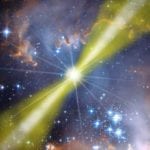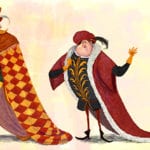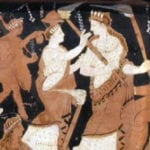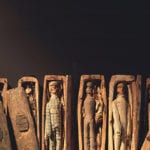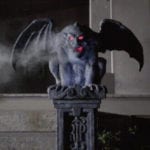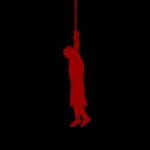 Technology
Technology  Technology
Technology  Our World
Our World 10 Ways Icelandic Culture Makes Other Countries Look Boring
 Misconceptions
Misconceptions 10 Common Misconceptions About the Victorian Era
 Mysteries
Mysteries 10 Strange Unexplained Mysteries of 2025
 Miscellaneous
Miscellaneous 10 of History’s Most Bell-Ringing Finishing Moves
 History
History 10 Great Escapes That Ended Right Back in Captivity
 Weird Stuff
Weird Stuff 10 Fascinating Things You Might Not Know About Spiders
 Food
Food 10 Everyday Foods You Didn’t Know Were Invented by the U.S. Military
 History
History 10 Odd Things Colonial Americans Kept at Home
 Weird Stuff
Weird Stuff 10 Superstitious Beliefs That Once Consumed Entire Cultures
 Technology
Technology 10 Scientific Breakthroughs of 2025 That’ll Change Everything
 Our World
Our World 10 Ways Icelandic Culture Makes Other Countries Look Boring
 Misconceptions
Misconceptions 10 Common Misconceptions About the Victorian Era
Who's Behind Listverse?

Jamie Frater
Head Editor
Jamie founded Listverse due to an insatiable desire to share fascinating, obscure, and bizarre facts. He has been a guest speaker on numerous national radio and television stations and is a five time published author.
More About Us Mysteries
Mysteries 10 Strange Unexplained Mysteries of 2025
 Miscellaneous
Miscellaneous 10 of History’s Most Bell-Ringing Finishing Moves
 History
History 10 Great Escapes That Ended Right Back in Captivity
 Weird Stuff
Weird Stuff 10 Fascinating Things You Might Not Know About Spiders
 Food
Food 10 Everyday Foods You Didn’t Know Were Invented by the U.S. Military
 History
History 10 Odd Things Colonial Americans Kept at Home
 Weird Stuff
Weird Stuff 10 Superstitious Beliefs That Once Consumed Entire Cultures
10 More Unsolved Coded Mysteries You Could Decipher Today
Human desire to conceal is rivaled by our desire to reveal. Mystery texts arise anytime an inventive author conceals the key to understanding some new method of writing, but mystery texts go viral whenever the code suggests the key is easy to recover. Maybe the author is alive and deliberately withholding information, or maybe the key appears entirely lost to the past.
Listverse readers already know many still-unsolved mystery writings of the past, like the Voynich manuscript and the Phaestos disk, and treasure-hunt codes of the present, like the Kryptos cipher sculpture that was recently updated with the “Berlin clock” hint. Now you can test your discovery skills against a fresh slate listing ten more of the most compelling unsolved codes and ciphers ever concealed, all of which have supernaturalist or globalist backstories. Your rewards, described below, include buried treasures, rewrites of history, and even mystical insights into the universe.
See Also: Top 10 Secret Codes You Aren’t Meant To Know
10 Faust’s Magic Disc
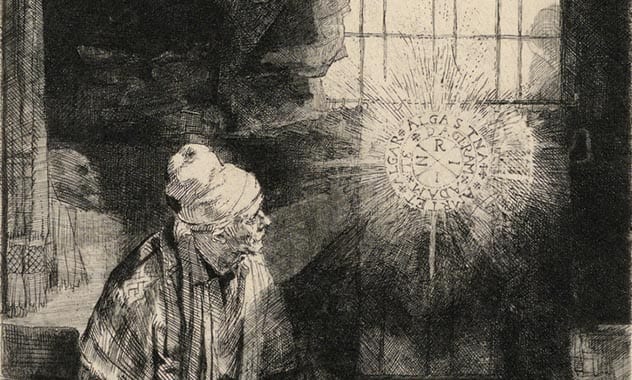
Dmitri Borgmann, linguistics pioneer, successfully cracked many codes but left two “bafflers” in his authoritative work “Beyond Language”. Besides the inscrutable French government formula for pricing funerals, Borgmann asks for help solving the mystery text Rembrandt etched into “Faust in His Study, Watching a Magic Disc” (about 1652, with prints held by the Metropolitan Museum of Art and Pierpont Morgan Library). Rembrandt’s glowing disc contains “INRI” in the center, and (reading clockwise from the southeast and outward) “ADAM + TE + DAGERAM / AMRTET + ALGAR + ALGASTNA”. The text remains an “indecipherable anagram”,[1] although “INRI” is usually understood as representing the inscription on the cross of Jesus.
Borgmann suggests the “surely irrelevant” occurrence of AMSTERDAM, Rembrandt’s home, among the outer letters, and some “most unconnected” Latin anagrams: “ADAM is a cyclic transposal of DAMA (‘fallow-deer’)”.[2] Twentieth-century mystic Samael Aun Weor made use of the same text, rendering it “adam te dageram amrtet algar algas tinah”, as an inscription for a magic mirror.[3] However, he appears merely to be recycling the text, which Borgmann suspects came from Rembrandt’s neighbor, Samuel Menasseh ben Israel, who had deep occult interests[4] and married into the rabbinic Abarbanel family. Is ADAM plaintext, or for that matter is INRI part of the anagram? Should we rely on such partial anagrams as Meradag (Mordechai), Graal, or Satan as having any meaning? Borgmann concludes playfully, “the anagram … remains a cabalistic conundrum. Does it inspire you to try your own hand at it?”
9 Cicada 3301’s First Book
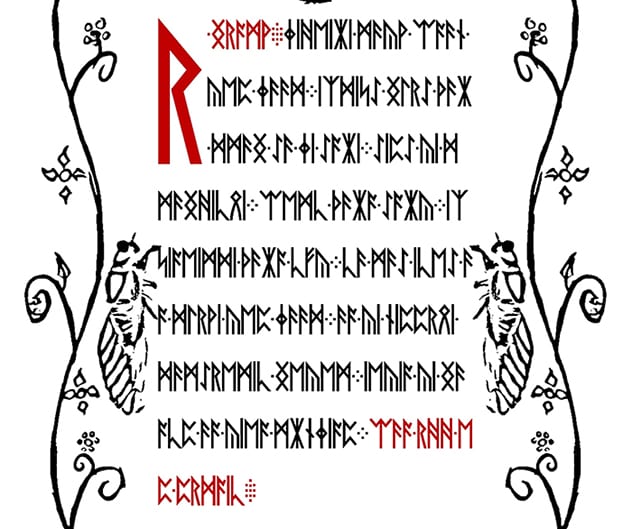
Cicada 3301, anonymous publisher of challenge data texts, is controversial enough to need its own article. “The Washington Post” ranked the organization among the top five “eeriest” internet mysteries.[5] For three years, Cicada 3301 claimed to use complex data encryption puzzles to recruit the best codebreakers, the most interested in data privacy. Unsurprisingly, very few successful solvers came forward to disclose what they learned about the organization, even while it appears that the victorious “recruits” were assigned to engineer novel web privacy tasks.
A Cicada ebook, “Liber Primus” (Latin for “First Book”), had been discovered in 2014, completely written in runes, and with cover art of a hand holding a compass in the traditional triangular pose. Approximately half of the text has been solved, beginning with the words, “A warning: Believe nothing from this book”; but solvers despaired of further solution or anything more meaningful being recovered. Suddenly in 2016, a single tweet was released, bearing the same digital signature that verified its origin with Cicada 3301, and stating that “Liber Primus is the way”.[6] To this date, the unknown rewards to be claimed upon solving Cicada’s hardest challenges remain publicly unclaimed.
8 Swift’s Little Languages

Like musician Edward Elgar,[7] author Jonathan Swift frequently experimented with impromptu coding in his art, most notably in “Gulliver’s Travels” and the posthumous “Journal to Stella”. Lemuel Gulliver is frequently taken as a pun on “gullible” (even as Lemuel is known incongruously to be a nickname for Solomon); the lands he visits, Lilliput and Brobdingnag, sound like “little” and “big”. On a deeper level, Isaac Asimov speculated on many of Swift’s etymologies,[8] holding that Swift’s “Lindalino”, which suffered government impositions, was a “double Lin” and therefore represented the city of Dublin, which Swift regarded as similarly beseiged. Most notably, the invented word “Yahoo”, taken as an insult but now a dominating search engine, is probably a corruption of the divine name “Yahweh”.[9]
Much work has also gone into understanding a collection of Swift’s letters to close friend Esther Johnson, published as “A Journal to Stella”. Like the name Stella itself (taken for Esther), the letters are often full of nonce language that involves an irregular set of phonetic and linguistic changes that Swift believed Johnson would understand.[10] Often resembling baby talk, this “little language” remains incompletely solved. Swift’s “word-doodling” is so various in these and other works that much new ground remains to be solved despite past scholarly forays.[11]
7 Serafini’s Uncyclopedia

Inspired by the medieval Voynich Manuscript, architect Luigi Serafini handwrote and hand-drew an immense encyclopedic work, published in two volumes in 1981. Many discovered this book via Douglas Hofstadter’s review in his monthly column (and later book), “Metamagical Themas”. The pictures, which Hofstadter in one sentence called “grotesque and disturbing … beautiful and visionary”, start with the famous cover art of a lovemaking couple methodically transforming into an alligator.[12]
Many years later, Serafini discounted his literary output as having “become” the same as automatic writing, even though many regularities in the Codex script, such as its page numbering, have been discovered.[13] Is the work entirely to be understood merely as an absurdist fantasy universe without linguistic content, or is meaning inherent in the allegedly “automatic” text? Readers are still debating!
6 The Holy Codex of Rohonc

By 1838, Count Gusztav Batthyany had accumulated myriads of books from all over the world in his home, the Castle of Rohonc (now called Rechnitz, Austria). Very many of these were at that time donated to the Hungarian Academy of Sciences, which shortly discovered that one codex of nearly untraceable origin was full of incomprehensible script characters, regarded by some contemporaries as a meaningless hoax. Unlike most other unsolved codes, the “pictures are almost primitive … and the codes are not especially decorative”.[14] As a further complication, the cipher alphabet contains at least 100 to 200 characters, often confusingly joined together, and nobody is certain what original language might have been used.
A clue may appear in the catalogue of the Batthyany library from 1743, where one entry translates as “Hungarian prayers in one volume, size duodecimo”.[15] Work by Gabor Tokai and Levente Zoltan Kiraly in 2010-2011 seems to be converging on some characters representing New Testament books and chapters, while some illustrations retell the Passion of Christ.[16] While this work seems promising, it may provide no more structure than the page numbers of Serafini’s much more elaborate codex. Does Rohonc display more “certain piety” than Serafini? Time must tell.
5 Hal Gashtan’s Microcosm

“In July 1984 an envelope was placed in the room pictured above …” reads the teaser of “Microcosm”, a psychedelically illustrated treasure book by “Hal Gashtan”, promising one thousand pounds to the decoder of the name within the envelope. Two magazines, “Creative Computing” (America) and “Your Computer” (Britain), sponsored this simple-looking BASIC-language programming contest, thinking it might briefly challenge ’80s PC users. Simply join the correct phrases from the book’s poetry to one of the given 20-letter keys using the columnar decryption program provided, and the answers lead to the phone number and secret name.[17]
Unfortunately, the publisher, Lazy Summer Books (now YouCaxton Publications), underestimated the permutational challenge involved, well beyond that of the typical BASIC PC. Each of thirteen keys requires thirteen correct choices out of sixteen possibilities each (many quadrillions of combinations), before an unspecified final combination of the thirteen solutions is required. Two clues were later released by “Your Computer”: George Washington, and computer names.[18] In the latter case, the correct 13 computers were found, but led only to the first solution text “FIND THIRTEEN NOT ME”, leaving it unclear whether this was indeed one of the final thirteen texts. The author has disappeared, and the illustrator (possibly Nigel Mynheer) has not been forthcoming. In short, no internet solve team has ever coalesced, and neither brute force nor intuitive solution has ever been successfully marshaled against the mysterious author.
4 Pink Floyd’s Publius
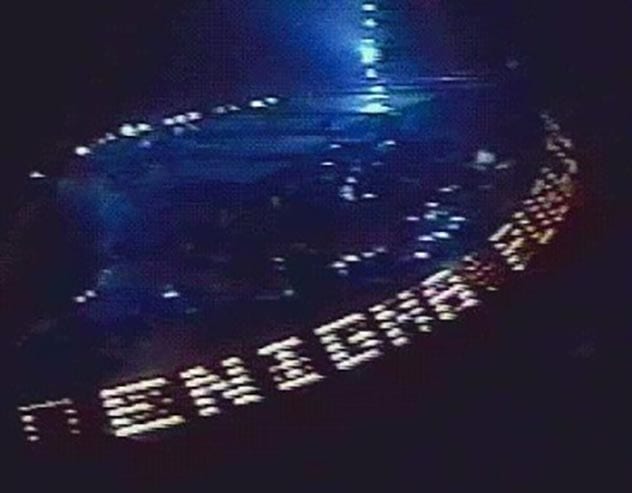
In a more widely known puzzle marketing campaign that apparently failed, Pink Floyd’s album “Division Bell” was released in 1984 to promote a world tour. The album’s title was proposed by author Douglas Adams, the cover art’s tantalizing head sculptures were photographed in front of Ely Cathedral, and additional edgy, discontinuous album artwork was provided by graphic designer Storm Thorgerson. With the tour ongoing, an anonymized internet persona named Publius proposed on Usenet that within the album lurked an enigma, where “there is a central purpose and a designed solution …. a unique prize has been secreted.” On July 16, 1994, Publius prophesied that Pink Floyd would verify the enigma’s existence, which happened on the 18th when programmable stage lights briefly displayed the words “PUBLIUS ENIGMA”, during the band’s last U.S. event.[19]
Despite further confirms and internet hints, no convincing solution appeared, no prize was awarded, and the puzzle continues fascinating fans today. Lighting designer Marc Brickman said in 1995 that he had programmed the repeated “ENIGMA” lights under the orders of band manager Steve O’Rourke, who had given Brickman’s idea of internet exposure to “some guy of Washington DC … in the encryption game”.[20] Drummer Nick Mason later stated that an EMI Records employee with encryption experience, who had also worked for President Reagan, designed the enigma, and the prize was more intangible, “something like a crop of trees planted in a clear cut area of forest”.[21] Putative solutions include references to single or double 11s, as well as the writer of PubliusEnigma.blog, who claims actually to be the intended solution, explaining that the album regularly refers to herself.[22]
3Copious Masonic Mnemonics
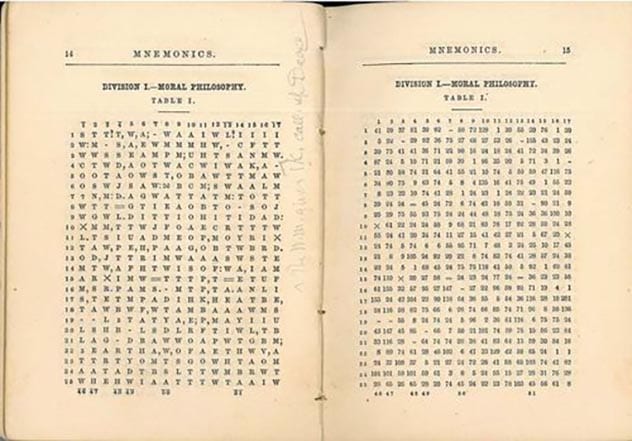
If that weren’t enough, our top three codes all involve known Freemason links. In 1981, the staff of fledgling puzzle magazine “Games” (in their first spinoff publication, “The Four-Star Puzzler”) asked for “help in solving the mystery” of an encoded 1860 book. Aside from its hefty title, “Written Mnemonics: Illustrated by Copious Examples From Moral Philosophy, Science, and Religion”, the book consists essentially of left-hand letter grids opposite right-hand number grids. The “Puzzler” also reproduced a back-cover chart listing number triads for the book’s divisions I-III (the book helpfully says in plaintext, e.g., “DIVISION I. — MORAL PHILOSOPHY”), where the first number is even (like a left-hand page number) and the other two are often “1 1” (like a mnemonic start location). The “Puzzler” speculated it contained Civil War codes but never got to run the full followup report its editors intended for a future issue.[23]
Several other copies of the book are alluded to on the internet; they typically have owners’ names and 1860s dates within the front cover and the same mysterious charts. The book’s basic purpose has been generally determined: it is “an example of a Masonic ritual cipher … which can be read if one has the key to decrypt it”.[24] In 1931, a Mason named Ray Denslow described the method in detail in “The Masonic Conservators”, now a public-domain work. The three divisions represented the first three degrees of Freemasons (“Moral Philosophy” meant “Entered Apprentice”), the letters and numbers were a book code (“T 9” meant “the”), and the contents chart indicated the rituals involved (“Cong.” meant “to congregate”). The author was Rob Morris, a Mason who created the Conservator movement in an attempt to keep Masonic lecture texts consistent; he began with wide approval but his method was deprecated later in the 1860s because it was held to contain omissions and errors and to come too close to revealing sworn secrets.[25] Yet, if the book key (called the “spelling book”) could be located or reconstructed, would an early source of authentic Masonic ritual be laid bare before the general public?
2Secrets of … Michael Stadther
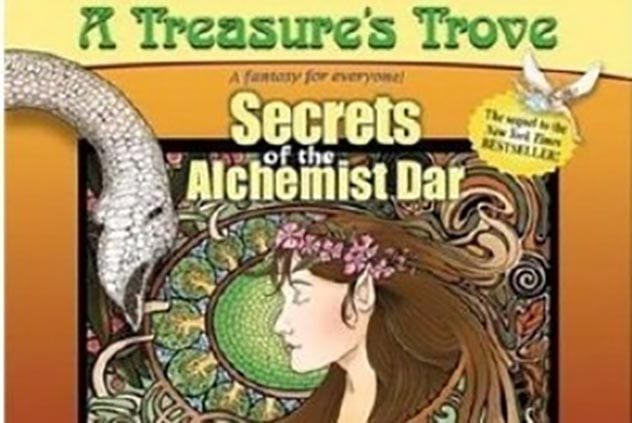
Inspired by Kit Williams’s “Masquerade”, author Michael Stadther published a successful puzzle book, “A Treasure’s Trove”, in 2004, for “children of all ages”. Clues led solvers to locations in fourteen state parks where tokens had been secreted; in 2005 Stadther redeemed these tokens by awarding hunters with fourteen jewels worth one million dollars, on the “Today” show.[26] Solvers looked forward to his second book, 2006’s “Secrets of the Alchemist Dar”, even more lavishly illustrated and confusingly encrypted. One hundred tokens with redemption value of two million dollars in diamonds were represented.
It is clear that “The Alchemist Dar” was merely an anagram of “Michael Stadther”, but totally unclear how the hundred locations can be found, as Stadther’s company entered dispute-related bankruptcy in 2007 before the hunt could be completed, so no official Dar redemptions have taken place. In 2012 Stadther promised to release hints until full solution “even though there is no possibility for someone to win a ring.” For instance, of the mystery language in his book, Stadther says, “Hest is English”; but these leads have not helped.[27] Stadther died in 2018 in Coronado, California, taking many secrets with him. In particular, why were two Freemason-connected texts, the Oak Island 90-foot-deep stone and the Beale cipher, numbers 2 and 3 in Stadther’s 2004 book, “100 Puzzles, Clues, Maps, Tantalizing Tales, and Stories of Real Treasure”, if the book was intended “to get you thinking about treasures” and to help you see Stadther’s own hunt clues?[28]
1 Cole’s Solution to Beale’s Cipher

Readers know that in 1885 “The Beale Papers” was a money-making pamphlet; it was published (and probably written) by James B. Ward, who became a Master Mason in 1863 (during the Conservator era). The pamphlet told the story, possibly invented, of a Thomas J. Beale who hid tons of gold and silver in Bedford County, Virginia, in the 1820s. Temptingly, it contained three ciphertexts, one of which was presented as already easily solved, a simple book cipher based on the Declaration of Independence that described the treasure’s contents. The other two, unsolved, described location and heirs.[29] Kryptos solver Jim Gillogly later pointed out that cipher one (locating the treasure) contained a highly improbable alphabetic sequence; he favors a hoax interpretation but recognizes the possibility “that another level of encryption (e.g. elimination of nulls) must be stripped away”.[30]
The Tripod website BealeSolved claimed the vault was found in 2001, providing photos, and presented complete solutions to ciphers one and three, but stated nothing was left of the original treasure. However, the solutions were no book ciphers as others expected, because identical numbers repeatedly yielded different alleged plaintext, and no solution method was given; solver Daniel Cole died during the hunt in 2001. A Masonic background, including “very high degree”, was “a common bond” between Cole and fellow treasure-hunter Gary Hutchinson.[31] The BealeSolved site was composed in 2001 by SWN, probably Steven Ninichuck, the third member of the team. Ninichuck and Hutchinson reported to Michael Stadther that they had solved everything correctly but had merely been beaten to the punch. But then why did Ninichuck post an unverifiable solution, alongside Vigenere systems with the keys “blue” and “point-to-point”? Why did Hutchinson say that a former hunter for “T. J.” Beale’s gold was improbably named “G. W. Hunt”? Why did Stadther say the solution was “deciphered … from a Masonic ritual”? How did Cole compose his own manuscript, if not by using something like written mnemonics; as Stadther asks, “When will we see how the Location cipher was broken?”
For more lists like this, check out 10 Secrets Buried In Crypts, 10 ‘Secret Cities’ That Were Kept Hidden From The Public.
About The Author: John J. Bulten has been puzzle editor for independent news network WND, inventor of the 3-D crossword, and the best Scrabble player in Florida.
